Umar Farooq
INTERPOS: Interaction Rhythm Guided Positional Morphing for Mobile App Recommender Systems
Jun 14, 2025Abstract:The mobile app market has expanded exponentially, offering millions of apps with diverse functionalities, yet research in mobile app recommendation remains limited. Traditional sequential recommender systems utilize the order of items in users' historical interactions to predict the next item for the users. Position embeddings, well-established in transformer-based architectures for natural language processing tasks, effectively distinguish token positions in sequences. In sequential recommendation systems, position embeddings can capture the order of items in a user's historical interaction sequence. Nevertheless, this ordering does not consider the time elapsed between two interactions of the same user (e.g., 1 day, 1 week, 1 month), referred to as "user rhythm". In mobile app recommendation datasets, the time between consecutive user interactions is notably longer compared to other domains like movies, posing significant challenges for sequential recommender systems. To address this phenomenon in the mobile app domain, we introduce INTERPOS, an Interaction Rhythm Guided Positional Morphing strategy for autoregressive mobile app recommender systems. INTERPOS incorporates rhythm-guided position embeddings, providing a more comprehensive representation that considers both the sequential order of interactions and the temporal gaps between them. This approach enables a deep understanding of users' rhythms at a fine-grained level, capturing the intricacies of their interaction patterns over time. We propose three strategies to incorporate the morphed positional embeddings in two transformer-based sequential recommendation system architectures. Our extensive evaluations show that INTERPOS outperforms state-of-the-art models using 7 mobile app recommendation datasets on NDCG@K and HIT@K metrics. The source code of INTERPOS is available at https://github.com/dlgrad/INTERPOS.
* 10 pages, 8 tables, 3 figures
What Users Value and Critique: Large-Scale Analysis of User Feedback on AI-Powered Mobile Apps
Jun 12, 2025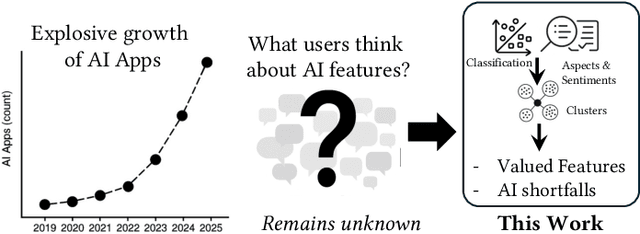
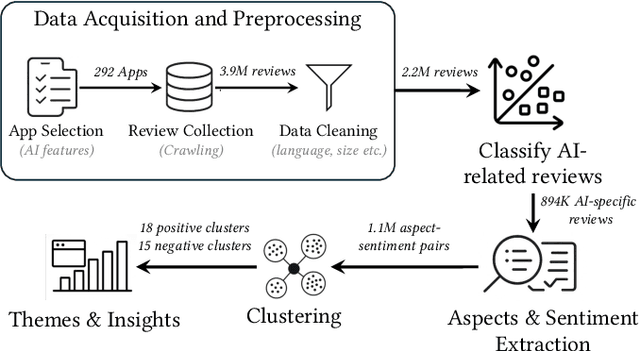
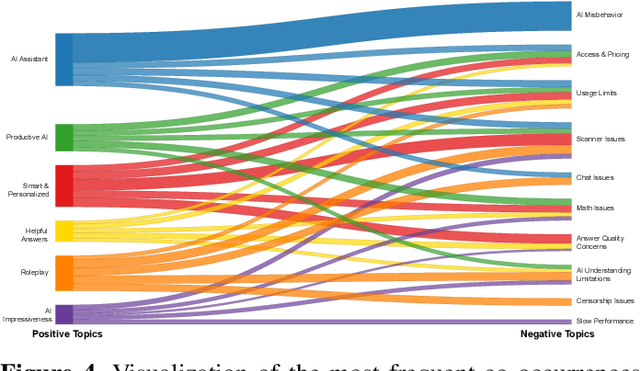
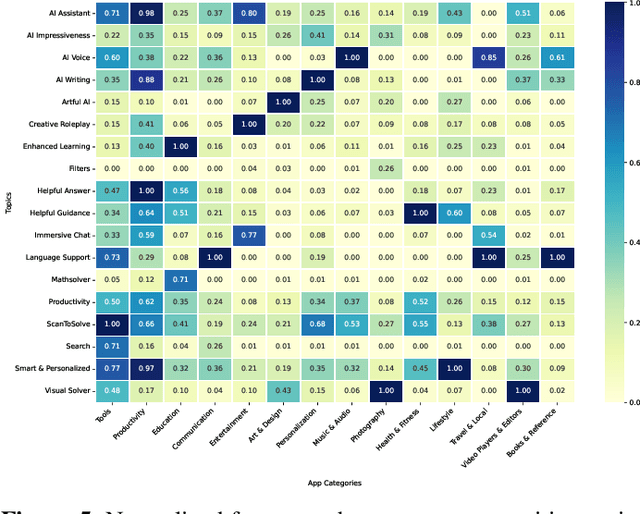
Abstract:Artificial Intelligence (AI)-powered features have rapidly proliferated across mobile apps in various domains, including productivity, education, entertainment, and creativity. However, how users perceive, evaluate, and critique these AI features remains largely unexplored, primarily due to the overwhelming volume of user feedback. In this work, we present the first comprehensive, large-scale study of user feedback on AI-powered mobile apps, leveraging a curated dataset of 292 AI-driven apps across 14 categories with 894K AI-specific reviews from Google Play. We develop and validate a multi-stage analysis pipeline that begins with a human-labeled benchmark and systematically evaluates large language models (LLMs) and prompting strategies. Each stage, including review classification, aspect-sentiment extraction, and clustering, is validated for accuracy and consistency. Our pipeline enables scalable, high-precision analysis of user feedback, extracting over one million aspect-sentiment pairs clustered into 18 positive and 15 negative user topics. Our analysis reveals that users consistently focus on a narrow set of themes: positive comments emphasize productivity, reliability, and personalized assistance, while negative feedback highlights technical failures (e.g., scanning and recognition), pricing concerns, and limitations in language support. Our pipeline surfaces both satisfaction with one feature and frustration with another within the same review. These fine-grained, co-occurring sentiments are often missed by traditional approaches that treat positive and negative feedback in isolation or rely on coarse-grained analysis. To this end, our approach provides a more faithful reflection of the real-world user experiences with AI-powered apps. Category-aware analysis further uncovers both universal drivers of satisfaction and domain-specific frustrations.
Optimized 3D Gaussian Splatting using Coarse-to-Fine Image Frequency Modulation
Mar 18, 2025
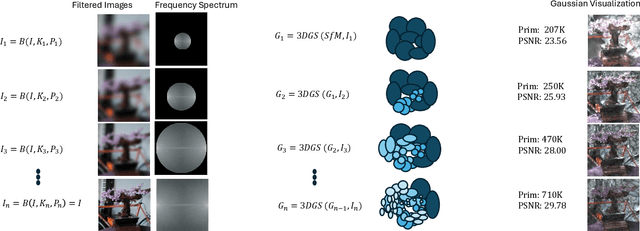
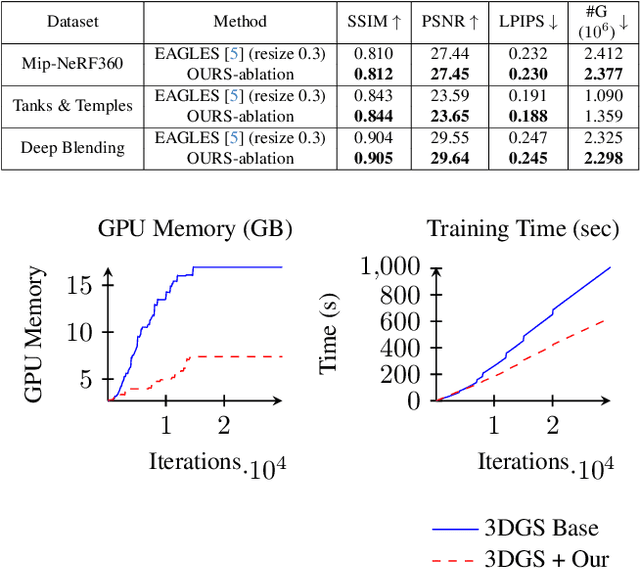

Abstract:The field of Novel View Synthesis has been revolutionized by 3D Gaussian Splatting (3DGS), which enables high-quality scene reconstruction that can be rendered in real-time. 3DGS-based techniques typically suffer from high GPU memory and disk storage requirements which limits their practical application on consumer-grade devices. We propose Opti3DGS, a novel frequency-modulated coarse-to-fine optimization framework that aims to minimize the number of Gaussian primitives used to represent a scene, thus reducing memory and storage demands. Opti3DGS leverages image frequency modulation, initially enforcing a coarse scene representation and progressively refining it by modulating frequency details in the training images. On the baseline 3DGS, we demonstrate an average reduction of 62% in Gaussians, a 40% reduction in the training GPU memory requirements and a 20% reduction in optimization time without sacrificing the visual quality. Furthermore, we show that our method integrates seamlessly with many 3DGS-based techniques, consistently reducing the number of Gaussian primitives while maintaining, and often improving, visual quality. Additionally, Opti3DGS inherently produces a level-of-detail scene representation at no extra cost, a natural byproduct of the optimization pipeline. Results and code will be made publicly available.
Looking into Black Box Code Language Models
Jul 05, 2024



Abstract:Language Models (LMs) have shown their application for tasks pertinent to code and several code~LMs have been proposed recently. The majority of the studies in this direction only focus on the improvements in performance of the LMs on different benchmarks, whereas LMs are considered black boxes. Besides this, a handful of works attempt to understand the role of attention layers in the code~LMs. Nonetheless, feed-forward layers remain under-explored which consist of two-thirds of a typical transformer model's parameters. In this work, we attempt to gain insights into the inner workings of code language models by examining the feed-forward layers. To conduct our investigations, we use two state-of-the-art code~LMs, Codegen-Mono and Ploycoder, and three widely used programming languages, Java, Go, and Python. We focus on examining the organization of stored concepts, the editability of these concepts, and the roles of different layers and input context size variations for output generation. Our empirical findings demonstrate that lower layers capture syntactic patterns while higher layers encode abstract concepts and semantics. We show concepts of interest can be edited within feed-forward layers without compromising code~LM performance. Additionally, we observe initial layers serve as ``thinking'' layers, while later layers are crucial for predicting subsequent code tokens. Furthermore, we discover earlier layers can accurately predict smaller contexts, but larger contexts need critical later layers' contributions. We anticipate these findings will facilitate better understanding, debugging, and testing of code~LMs.
MobileConvRec: A Conversational Dataset for Mobile Apps Recommendations
May 28, 2024Abstract:Existing recommendation systems have focused on two paradigms: 1- historical user-item interaction-based recommendations and 2- conversational recommendations. Conversational recommendation systems facilitate natural language dialogues between users and the system, allowing the system to solicit users' explicit needs while enabling users to inquire about recommendations and provide feedback. Due to substantial advancements in natural language processing, conversational recommendation systems have gained prominence. Existing conversational recommendation datasets have greatly facilitated research in their respective domains. Despite the exponential growth in mobile users and apps in recent years, research in conversational mobile app recommender systems has faced substantial constraints. This limitation can primarily be attributed to the lack of high-quality benchmark datasets specifically tailored for mobile apps. To facilitate research for conversational mobile app recommendations, we introduce MobileConvRec. MobileConvRec simulates conversations by leveraging real user interactions with mobile apps on the Google Play store, originally captured in large-scale mobile app recommendation dataset MobileRec. The proposed conversational recommendation dataset synergizes sequential user-item interactions, which reflect implicit user preferences, with comprehensive multi-turn conversations to effectively grasp explicit user needs. MobileConvRec consists of over 12K multi-turn recommendation-related conversations spanning 45 app categories. Moreover, MobileConvRec presents rich metadata for each app such as permissions data, security and privacy-related information, and binary executables of apps, among others. We demonstrate that MobileConvRec can serve as an excellent testbed for conversational mobile app recommendation through a comparative study of several pre-trained large language models.
MobileRec: A Large-Scale Dataset for Mobile Apps Recommendation
Mar 12, 2023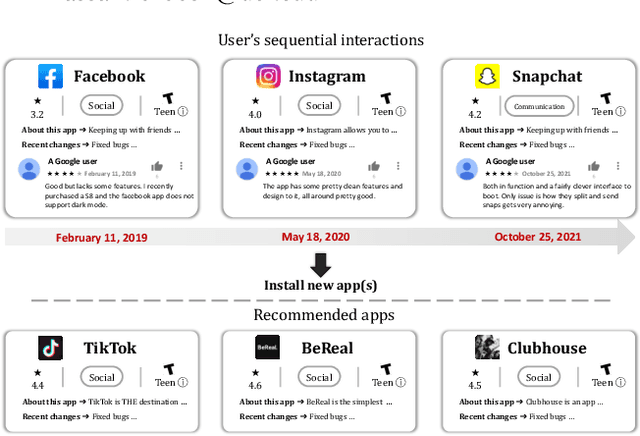



Abstract:Recommender systems have become ubiquitous in our digital lives, from recommending products on e-commerce websites to suggesting movies and music on streaming platforms. Existing recommendation datasets, such as Amazon Product Reviews and MovieLens, greatly facilitated the research and development of recommender systems in their respective domains. While the number of mobile users and applications (aka apps) has increased exponentially over the past decade, research in mobile app recommender systems has been significantly constrained, primarily due to the lack of high-quality benchmark datasets, as opposed to recommendations for products, movies, and news. To facilitate research for app recommendation systems, we introduce a large-scale dataset, called MobileRec. We constructed MobileRec from users' activity on the Google play store. MobileRec contains 19.3 million user interactions (i.e., user reviews on apps) with over 10K unique apps across 48 categories. MobileRec records the sequential activity of a total of 0.7 million distinct users. Each of these users has interacted with no fewer than five distinct apps, which stands in contrast to previous datasets on mobile apps that recorded only a single interaction per user. Furthermore, MobileRec presents users' ratings as well as sentiments on installed apps, and each app contains rich metadata such as app name, category, description, and overall rating, among others. We demonstrate that MobileRec can serve as an excellent testbed for app recommendation through a comparative study of several state-of-the-art recommendation approaches. The quantitative results can act as a baseline for other researchers to compare their results against. The MobileRec dataset is available at https://huggingface.co/datasets/recmeapp/mobilerec.
Proactive Prioritization of App Issues via Contrastive Learning
Mar 12, 2023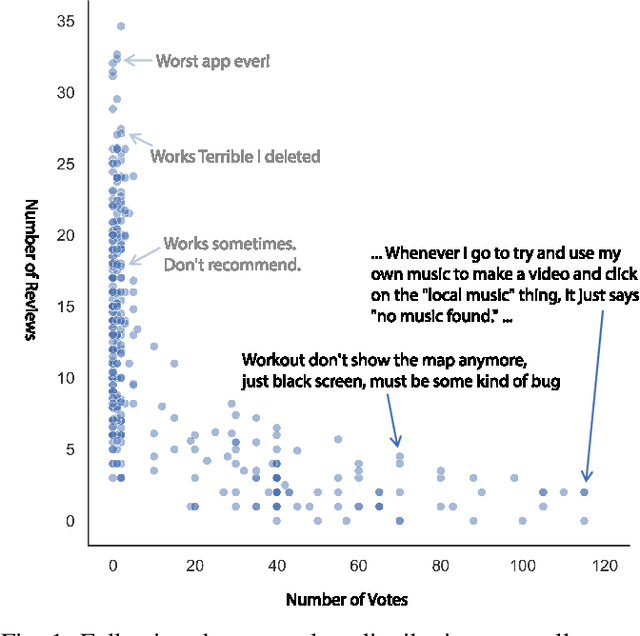



Abstract:Mobile app stores produce a tremendous amount of data in the form of user reviews, which is a huge source of user requirements and sentiments; such reviews allow app developers to proactively address issues in their apps. However, only a small number of reviews capture common issues and sentiments which creates a need for automatically identifying prominent reviews. Unfortunately, most existing work in text ranking and popularity prediction focuses on social contexts where other signals are available, which renders such works ineffective in the context of app reviews. In this work, we propose a new framework, PPrior, that enables proactive prioritization of app issues through identifying prominent reviews (ones predicted to receive a large number of votes in a given time window). Predicting highly-voted reviews is challenging given that, unlike social posts, social network features of users are not available. Moreover, there is an issue of class imbalance, since a large number of user reviews receive little to no votes. PPrior employs a pre-trained T5 model and works in three phases. Phase one adapts the pre-trained T5 model to the user reviews data in a self-supervised fashion. In phase two, we leverage contrastive training to learn a generic and task-independent representation of user reviews. Phase three uses radius neighbors classifier t o m ake t he final predictions. This phase also uses FAISS index for scalability and efficient search. To conduct extensive experiments, we acquired a large dataset of over 2.1 million user reviews from Google Play. Our experimental results demonstrate the effectiveness of the proposed framework when compared against several state-of-the-art approaches. Moreover, the accuracy of PPrior in predicting prominent reviews is comparable to that of experienced app developers.
AARSynth: App-Aware Response Synthesis for User Reviews
Aug 28, 2020Abstract:Responding to user reviews promptly and satisfactorily improves application ratings, which is key to application popularity and success. The proliferation of such reviews makes it virtually impossible for developers to keep up with responding manually. To address this challenge, recent work has shown the possibility of automatic response generation. However, because the training review-response pairs are aggregated from many different apps, it remains challenging for such models to generate app-specific responses, which, on the other hand, are often desirable as apps have different features and concerns. Solving the challenge by simply building a model per app (i.e., training with review-response pairs of a single app) may be insufficient because individual apps have limited review-response pairs, and such pairs typically lack the relevant information needed to respond to a new review. To enable app-specific response generation, this work proposes AARSynth: an app-aware response synthesis system. The key idea behind AARSynth is to augment the seq2seq model with information specific to a given app. Given a new user review, it first retrieves the top-K most relevant app reviews and the most relevant snippet from the app description. The retrieved information and the new user review are then fed into a fused machine learning model that integrates the seq2seq model with a machine reading comprehension model. The latter helps digest the retrieved reviews and app description. Finally, the fused model generates a response that is customized to the given app. We evaluated AARSynth using a large corpus of reviews and responses from Google Play. The results show that AARSynth outperforms the state-of-the-art system by 22.2% on BLEU-4 score. Furthermore, our human study shows that AARSynth produces a statistically significant improvement in response quality compared to the state-of-the-art system.
Measuring LDA Topic Stability from Clusters of Replicated Runs
Aug 24, 2018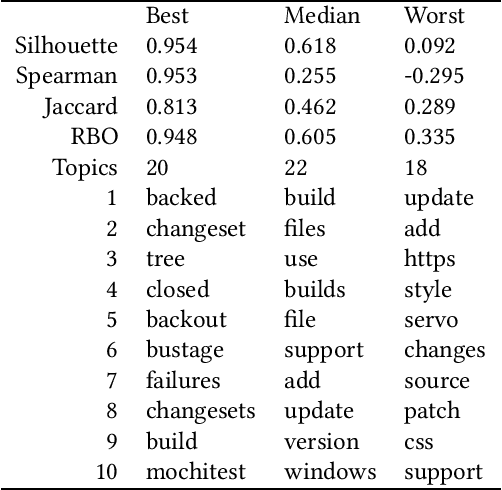

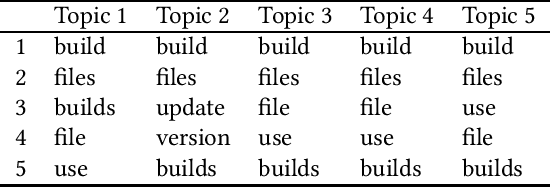

Abstract:Background: Unstructured and textual data is increasing rapidly and Latent Dirichlet Allocation (LDA) topic modeling is a popular data analysis methods for it. Past work suggests that instability of LDA topics may lead to systematic errors. Aim: We propose a method that relies on replicated LDA runs, clustering, and providing a stability metric for the topics. Method: We generate k LDA topics and replicate this process n times resulting in n*k topics. Then we use K-medioids to cluster the n*k topics to k clusters. The k clusters now represent the original LDA topics and we present them like normal LDA topics showing the ten most probable words. For the clusters, we try multiple stability metrics, out of which we recommend Rank-Biased Overlap, showing the stability of the topics inside the clusters. Results: We provide an initial validation where our method is used for 270,000 Mozilla Firefox commit messages with k=20 and n=20. We show how our topic stability metrics are related to the contents of the topics. Conclusions: Advances in text mining enable us to analyze large masses of text in software engineering but non-deterministic algorithms, such as LDA, may lead to unreplicable conclusions. Our approach makes LDA stability transparent and is also complementary rather than alternative to many prior works that focus on LDA parameter tuning.
 Add to Chrome
Add to Chrome Add to Firefox
Add to Firefox Add to Edge
Add to Edge